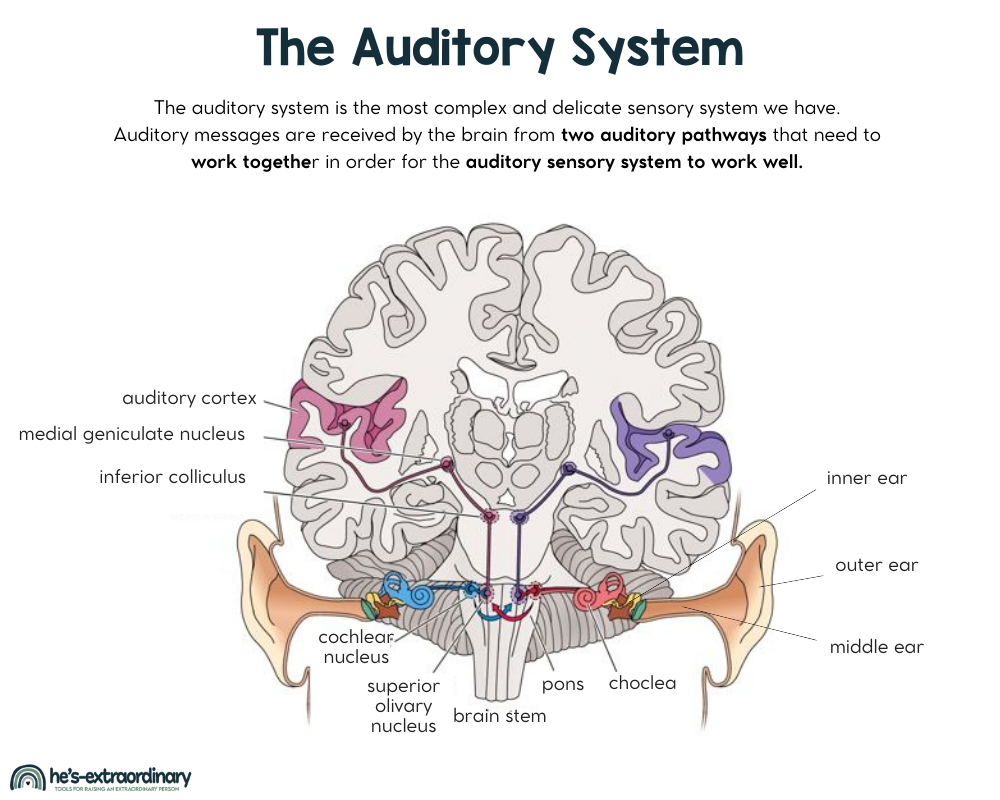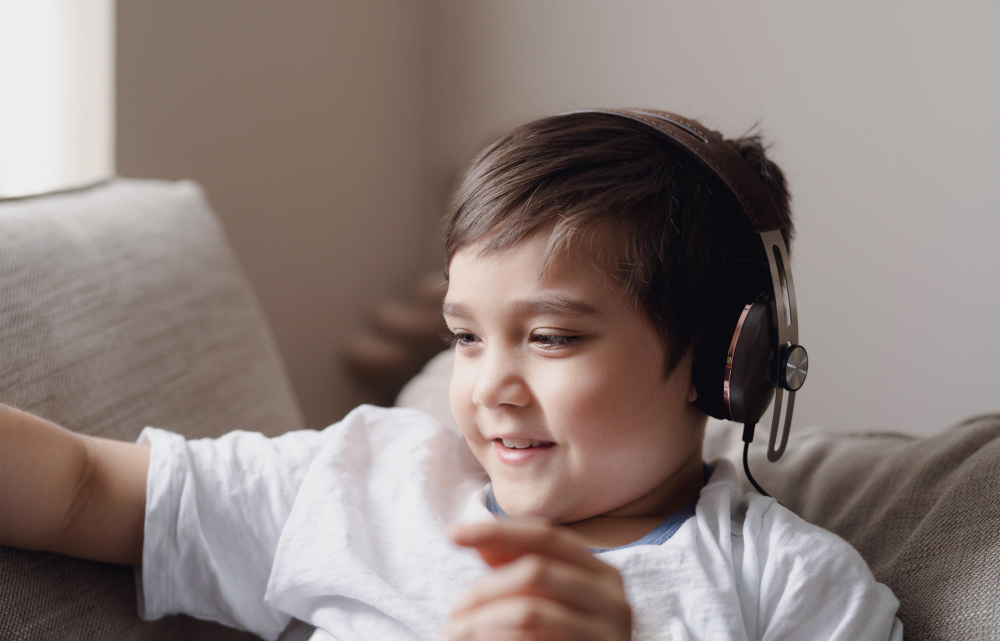The Auditory System – How it Works and Signs of Auditory Processing Issues
What’s inside this article: A look at how the auditory system (our sense of hearing) works and signs of possible auditory processing issues in children. Plus, sensory strategies to help kids with auditory processing differences.
Disclaimer: This post contains affiliate links.
The auditory system is the most complex and delicate sensory system we have. This system is responsible, of course, for our sense of hearing.
Auditory messages are received by the brain from two auditory pathways that need to work together in order for the auditory sensory system to work well.
To put into perspective just how sensitive this system is, The auditory system responds 1000 times faster than the visual system and detects vibrations as small as a hydrogen atom.
This post is part of a 10-part series on the sensory systems. Each part will contain a table of contents to help you easily navigate through the entire series.
Table of Contents:
- Introduction – The Sensory Spectrum
- The Tactile System
- The Auditory System
- The Visual System
- Proprioception
- Vestibular System
- Interoception
- The Olfactory System
- The Oral-Motor System
- Bilateral Coordination
Auditory Pathways
There are two auditory pathways. These are:
- The Peripheral Auditory System: This pathway involves the outer, middle, and inner ear. This pathway delivers all types of auditory sensory messages.
- The Central Auditory System: This pathway delivers only sensory messages received by the cochlear nucleus.

The Peripheral Auditory Pathway (Primary Pathway)
The peripheral auditory pathway works by transferring sound messages through the ear to the auditory cortex in the brain.
- The cartilage on the outer ear functions as a sound reflector, which helps us identify the direction in which the sounds we hear are coming.
- Then, sound vibrations travel and become amplified inside the ear – traveling to the middle ear. The bones inside the middle ear convert the sound vibrations into vibrations with higher pressure. They then enter the inner ear.
- The inner ear is filled with fluid and also contains the organs of the vestibular system. This is where the sound is converted from vibrations into neural signals for the brain to process.
- These neural signals travel through the brain to the auditory cortex, where they are decoded.
- Messages are interpreted based on how the brain processes these neural signals. A behavioral response occurs based on this interpretation.
Auditory Processing Challenges

If you have any concerns about your child’s hearing, it’s important to rule out hearing loss or damage first.
Sensory processing challenges related to the auditory system vary depending on what type of issues present. Here are some signs to watch for:
Sensory Discrimination and Perception Issues
Discrimination and perception issues occur when the brain is struggling to interpret and give meaning to sensory input.
- Difficulty telling the difference between two similar-sounding words, such as “chicken” and “kitchen”, or “sitter” and “sister”.
- Has trouble understanding what others are saying around them. This becomes worse in noisy environments.
- May struggle with reading and spelling. For example, writing or saying the sounds in the words in the incorrect order.
- Your child may appear to be listening earnestly but then their actions show they did not understand the directions correctly
- If you ask your child to repeat back what you just said – they can do it but the words are not in the correct order.
Modulation Issues
This occurs when the brain over- or under- responds to auditory input.
Over-Responsive (Auditory Defensiveness)
- Dislikes loud noises, may cover their ears frequently, higher-pitched sounds may be worse
- Reacts to background sounds that most people would filter out
- Struggles academically
- Hides or cries in response to loud noises at home. For example, the vacuum, blender, a dog barking, etc.
- Bothered or distracted by small sounds like a clock ticking or water dripping from a tap
- Afraid of public washrooms -due to the loud flushing toilets, hand dryers, etc.
Under-Responsive (Auditory Input Seeking)
- Always speaks loudly
- Prefers loud music or TV
- Makes their own noises whenever they are in a quiet environment
- May create noise by tapping an object on the table, humming, etc.
- Craves common background noises, for example, may always want the fan running
- Puts their ears up against things that are making a
sound . For example, toys, TV, a computer speaker, tablet, dryer, etc. - Doesn’t respond to important sounds such as the bell ringing at school or a parent calling their name.
Strategies for Managing Auditory Processing Differences
If your child struggles with input from the auditory system, the best way to help them is by modifying the environment. It’s important, especially at school, to make your child comfortable so they can learn.
The following ideas might help your child manage their responses to auditory input.
For Over-Responsiveness
- Keep the environment quiet. At school, consideration should be made for group sizes, seating arrangements, etc to minimize stressful stimuli for your child
- Give advanced warnings about loud sounds whenever possible – vacuuming, toilet flushing, fire drills, etc.
- When it’s not possible to keep the environment quiet, use headphones, or decibel reducing earplugs.
- Offer gum or crunchy snacks, or play light music as a distraction from irritating background sounds
- From Julie at My Mundane and Miraculous Life: Put a sticky note over the sensor on toilets that flush automatically. Check out her other tips for public bathrooms here.
For Under-Responsiveness
- Offer toys with plenty of auditory input – shakers, drums, musical toys, echo microphones, etc.
- Use songs to enhance learning new skills – songs about ABCs, shapes, colors, etc. may help solidify new learning concepts.
- Read sound books or use a Leapfrog reader
- Play music in the background
- Let your child sleep with a fan or music if they prefer
Recognizing and addressing auditory processing challenges, whether over-responsiveness or under-responsiveness, can markedly improve your child’s ability to interact and learn. Tailored accommodations and sensory strategies can significantly aid in managing these auditory processing differences.

